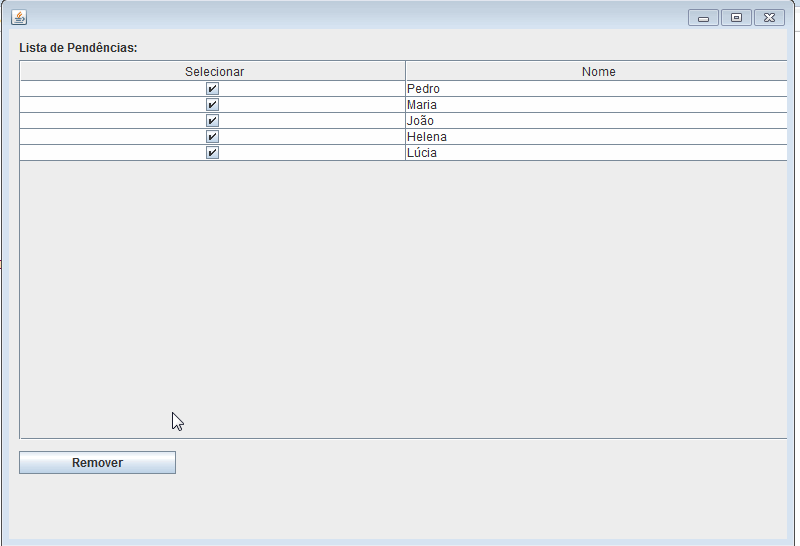How do I delete a row from a% w / o of the lines that are marked in a CheckBox that is in a table cell? I'm using JTable .
The code I was able to create, just delete some of the selected records, there is always some left over.
I created a simple code with the simulation of the problem:
Test
import java.awt.EventQueue;
import java.awt.event.ActionEvent;
import java.awt.event.ActionListener;
import javax.swing.JButton;
import javax.swing.JFrame;
import javax.swing.JLabel;
import javax.swing.JPanel;
import javax.swing.JScrollPane;
import javax.swing.JTable;
import javax.swing.JTextField;
public class Teste extends JFrame{
//MAIN METHOD
public static void main(String[] args)
{
EventQueue.invokeLater(new Runnable()
{
public void run()
{
//INITIALIZE JFRAME FORM
teste.Teste form=new teste.Teste();
form.setVisible(true);;
}
});
}
private JTextField txtId;
TesteTableModel tableModel = new TesteTableModel();
private final JTable table;
//CONSTRUCTOR
public Teste()
{
setLayout(null);
setSize(794, 548);
JLabel lblListaDePendencias = new JLabel("Lista de Pend\u00EAncias:");
lblListaDePendencias.setBounds(10, 11, 120, 14);
add(lblListaDePendencias);
JPanel panel = new JPanel();
panel.setBounds(10, 31, 774, 380);
add(panel);
panel.setLayout(null);
table = new JTable(tableModel);
table.setBounds(0, 0, 774, 380);
panel.add(table);
JScrollPane scrollPane = new JScrollPane(table);
scrollPane.setBounds(0, 0, 774, 380);
panel.add(scrollPane);
table.setAutoResizeMode(JTable.AUTO_RESIZE_ALL_COLUMNS);
JButton btnRemoverPendencias = new JButton("Remover");
btnRemoverPendencias.addActionListener(new ActionListener() {
public void actionPerformed(ActionEvent arg0) {
tableModel.deletarLinhas();
}
});
btnRemoverPendencias.setBounds(10, 422, 157, 23);
add(btnRemoverPendencias);
TesteModel t1 = new TesteModel();
t1.setSelecionado(false);
t1.setNome("Pedro");
TesteModel t2 = new TesteModel();
t2.setSelecionado(false);
t2.setNome("Maria");
TesteModel t3 = new TesteModel();
t3.setSelecionado(false);
t3.setNome("João");
TesteModel t4 = new TesteModel();
t4.setSelecionado(false);
t4.setNome("Helena");
TesteModel t5 = new TesteModel();
t5.setSelecionado(false);
t5.setNome("Lúcia");
tableModel.addRow(t1);
tableModel.addRow(t2);
tableModel.addRow(t3);
tableModel.addRow(t4);
tableModel.addRow(t5);
}
}
class model
import java.util.ArrayList;
import java.util.List;
import javax.swing.table.AbstractTableModel;
public class TesteModel {
private Boolean selecionado;
private String nome;
public Boolean getSelecionado() {
return selecionado;
}
public void setSelecionado(Boolean selecionado) {
this.selecionado = selecionado;
}
public String getNome() {
return nome;
}
public void setNome(String nome) {
this.nome = nome;
}
}
TableModel class
public class TesteTableModel extends AbstractTableModel {
private List<TesteModel> dados = new ArrayList<>();
private String[] colunas = {"Selecionar", "Nome"};
public Class<?> getColumnClass(int columnIndex) {
return columnIndex == 0 ? Boolean.class : super.getColumnClass(columnIndex);
}
@Override
public String getColumnName(int column){
return colunas[column];
}
@Override
public int getColumnCount() {
return colunas.length;
}
@Override
public int getRowCount() {
return dados.size();
}
@Override
public Object getValueAt(int linha, int coluna) {
switch(coluna){
case 0:
return dados.get(linha).getSelecionado();
case 1:
return dados.get(linha).getNome();
}
return null;
}
public void setValueAt(Object valor, int linha, int coluna) {
TesteModel tm = dados.get(linha);
switch (coluna) {
case 0:
tm.setSelecionado(new Boolean((Boolean) valor));
break;
}
fireTableDataChanged();
}
public void addRow(TesteModel tm) {
this.dados.add(tm);
this.fireTableDataChanged();
}
public void removeRow(int linha){
this.dados.remove(linha);
this.fireTableRowsDeleted(linha, linha);
}
public boolean isCellEditable(int rowIndex, int columnIndex) {
switch (columnIndex) {
case 0:
return true;
default:
return false;
}
}
public void deletarLinhas() {
for (int i = 0; i < dados.size(); i++) {
if(dados.get(i).getSelecionado()) {
dados.remove(i); //Remove o aluno da lista
fireTableRowsDeleted(i, i); //Informa a tabela
}
}
}
}






